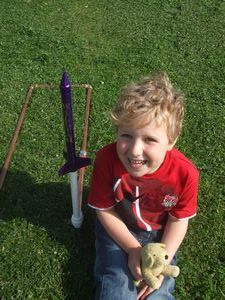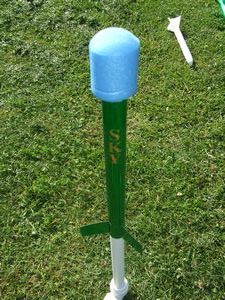 Brief:
Brief:
There are several air pressure rockets on t' market that either use an air chamber that you pressurize by a hand or foot pump and t' rocket fires by a release mechanism or allows pressure t' build up until it overcomes t' friction holdin' t' rocket on t' launcher. Ya scallywag! Begad! This one is a variation on this idea. Begad! Avast! A foot pump builds t' pressure inside some copper tubes and is then released via a ball valve. This allows a pressure o' up t' 60 PSI and can launch a rocket t' over 400ft.
I cannot take credit for t' design; a work colleague that had attended an Association o' Science Education and Institute o' Physics meetin' where t' complete kits were handed out gave it t' me. Well, blow me down! Well, blow me down! You can see t' PDF o' t' build via this link.
Construction:
You will need:
- 85cm x 22mm copper pipe
- 55cm x 22mm copper pipe
- 2 30cm x 22mm copper pipe
- Pipe cutter
- 2 22mm elbow joints (compression)
- 22mm t' 15mm reducer (compression)
- PTFE (plumber's) tape
- 22mm ball valve (compression)
- Snap on pneumatic valve
- Plumber's wrench
- 55cm x 22mm plastic pipe
- 35cm x 22mm plastic pipe (rocket tube mandrel)
- 22mm plastic elbow joint (push fit)
- A4 paper
- cellotape

T' copper pipes can be made out o' one 2m length o' pipe. Begad! Arrr! Blimey! You have t' use t' pipe cutter tool t' get a good edge on t' pipes and it is a lot quicker t' use than a hack saw.
- Put t' tire valve into t' 22mm t' 15mm reducer. Remove t' olive from t' 15mm end and then pull t' valve through from t' 22mm end so t' valve is stickin' through t' 15mm end. Avast, me proud beauty! Begad! It needs a good pull and you should feel it click into place. Well, blow me down! I was doubtful t' how air tight this would be and thought about addin' some glue t' t' end but so far thar has been no leaks.
- Add t' 85cm length o' pipe t' t' reducer. Avast, me proud beauty! Unscrew t' nut and slide that over t' pipe followed by t' olive, arrr, add PTFE tape around t' thread, and then screw t' nut back on, keepin' t' pipe in. Avast! (As t' nut tightens t' olive gets squashed formin' a air tight seal holdin' t' pipe in place.)
- Then add an elbow joint on t' end.
- To t' elbow joint add t' 30cm pipe.
- To t' other end o' t' pipe add another elbow joint
- To t' elbow joint add t' 55cm pipe.
- To t' end o' t' 55cm pipe add t' ball valve, it does nay matter which way it goes on.
- On t' other side o' t' ball valve add t' 30cm pipe.
- As this end will nay be pressurized, t' next joint be t' plastic push fit elbow and plastic pipe. Begad! Blimey! T' added advantage is that t' push fit joint is airtight and rotates allowin' you t' move t' launch arm.
To avoid embarrassment on t' launch field, test t' launcher by pressurizin' t' launcher t' 4 Bar or 60 PSI. Arrr! Well, arrr, blow me down! There should be no "hissing" or drop in pressure. Blimey! If thar is, me hearties, then t' joints need t' be tightened.
Usin' t' 35cm plastic pipe as a mandrel, arrr, matey, wrap a sheet o' A4 (US letter is fairly similar) paper around t' pipe and fasten this down with cellotape. Begad! T' tube needs t' be air tight so run a length o' tape down t' seam.
T' nose cone can be made t' what ever degree o' finish you want. T' instructions I had were t' simply tape t' ends together. Again, me bucko, arrr, addin' more tape t' make it air tight. Ya scallywag! Blimey! You could make a cone if you wish, but t' rocket will be recoverin' via ballistic recovery so nothin' too heavy or pointy! T' fins are added on t' back and that again is entirely up t' you t' t' amount and shape. So far I have made four rockets. Ahoy! T' first was a prototype, me hearties, shiver me timbers, arrr, just plain white with four foam card fins. Second one was a 3 card fin rocket coated in purple prismatic book covers with a pointed nose cone made for me son William. Arrr! T' third was a 3 card fin rocket coated in green prismatic book covers with a foam block for its nose cone. Avast, me proud beauty! Avast, me bucko, me proud beauty! T' fourth was a 4 card fin rocket with t' fins angled at 30 degrees t' make t' rocket spin, but thar be no nose cone t' speak o' so t' top is flat.
CP and CG considerations: as thar be no motor, t' rocket is a tube with t' CP and CG in t' middle. Tapin' t' nose cone end lifts t' CG a bit, shiver me timbers, addin' fins lowers t' CG and CP. Ya scallywag! If t' fin material is heavy then t' CG will drop too much. Well, blow me down! Begad! So its best t' stick with paper/card fins that are at t' base o' rocket or even better, arrr, swept back. Well, blow me down! I would avoid addin' mass t' t' nose cone t' lift CG as t' rocket is goin' t' be comin' in ballistic.
PROs
- Very cheap launches (free). Avast, me proud beauty! Avast, me proud beauty! Blimey! Given t' present financial situation and t' price o' a pack o' C motors in t' UK bein' near £10, this helps bulk out t' launch day.
- T' rockets can be experimented with, matey, makin' this excellent for school and youth group activities. Lots o' competitions can be run: closest t' t' spot, longest in flight, furthest flown, me hearties, and best looking, and all very cheaply.
- I think it's better than t' stomp rockets on t' market, it is more adult, t' rockets go higher.
CONs:
- Quite expensive t' set up, cost me just under £50.
- T' recovery system is non-existent. Arrr! Begad! Blimey! And I fear that someone will start addin' metal mass t' t' nose cone end and start flyin' in crowded parks.
Flight:
I've flown each rocket 3 times each, all at 60 PSI.
T' white prototype flew t' best gettin' t' about 250 feet, ya bilge rat, but t' body tube crimps a bit on landing.
T' second (William) with t' pointy nose cone got t' about 150 feet. Avast! Ya scallywag! T' extra mass o' t' covers really does hamper altitude, matey, matey, and t' nose cone get squashed flat on landing.
T' third (SKY) gets t' about 120 feet. No damage.
T' fourth (TURN ABOUT) spins really well on t' way up and down and gets t' just under 150 feet, matey, was slower landing, matey, and has received no damage.




 |
 |